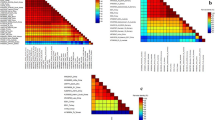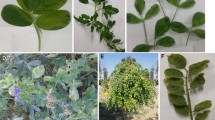Abstract
Based on the serological relationships of nucleocapsid proteins (NPs), a tospovirus species can be classified as a member of a serogroup or a distinct serotype, which greatly helps virus identification and disease diagnosis. Recent studies reported that distinct tospovirus species sharing above 51.8 % amino acid (aa) identity in their NPs may be serologically related. Two phylogenetically related peanut-infecting tospovirus species, Peanut chlorotic fan-spot virus (PCFV) in Taiwan and Peanut yellow spot virus (PYSV) in India, were previously considered as distinct serotypes, since no serological relationship has been established. To verify the serological relationship of PCFV and PYSV, the NP of PCFV was purified from leaf tissues of the infected Chenopodium quinoa plants and used to produce polyclonal antiserum (RAs-PCFV NP) and a monoclonal antibody (MAb-PCFV NP). Polyclonal antiserum to the bacterially expressed NP of PYSV (RAs-PYSV NP) was also prepared. RAs-PCFV NP reacted with the homologous PCFV NP and the bacterial-expressed PYSV NP and tissue extracts of PYSV-infected plants. Reciprocally, RAs-PYSV NP reacted with the homologous bacterial-expressed PYSV NP and the tissue extracts of PYSV-infected or PCFV-infected plants. In addition, MAb-PCFV NP reacted only with the tissue extracts of PCFV-infected plants. Our results demonstrate that PCFV NP is serologically related to PYSV NP and they should be classified as members of a unique serogroup.







Similar content being viewed by others
References
Chen, C. C., & Chiu, R. J. (1996). A tospovirus infecting peanut in Taiwan. Acta Horticulturae, 431, 57–67.
Chen, C. C., Chen, T. C., Lin, Y. H., Yeh, S. D., & Hsu, H. T. (2005a). A chlorotic spot disease on calla lilies (Zantedeschia spp.) is caused by a tospovirus serologically but distantly related to Watermelon silver mottle virus. Plant Disease, 89, 440–445.
Chen, T. C., Hsu, H. T., Jain, R. K., Huang, C. W., Lin, C. H., Liu, F. L., et al. (2005b). Purification and serological analyses of tospoviral nucleocapsid proteins expressed by Zucchini yellow mosaic virus vector in squash. Journal of Virological Methods, 129, 113–124.
Chen, T. C., Huang, C. W., Kuo, Y. W., Liu, F. L., Hsuan Yuan, C. H., Hsu, H. T., et al. (2006). Identification of common epitopes on a conserved region of NSs proteins among tospoviruses of Watermelon silver mottle virus serogroup. Phytopathology, 96, 1296–1304.
Chen, T. C., Lu, Y. Y., Cheng, Y. H., Chang, C. A., & Yeh, S. D. (2008). Melon yellow spot virus in watermelon: a first record from Taiwan. Plant Pathology, 57, 765.
Chen, T. C., Lu, Y. Y., Cheng, Y. H., Li, J. T., Yeh, Y. C., Kang, Y. C., et al. (2010). Serological relationship between melon yellow spot virus and Watermelon silver mottle virus and differential detection of the two viruses in cucurbits. Archives of Virology, 155, 1085–1095.
Chen, T. C., Lu, Y. Y., Kang, Y. C., Li, J. T., Yeh, Y. C., Kormelink, R., et al. (2011). Detection of eight different Tospovirus species by a monoclonal antibody against the common epitope of NSs protein. Acta Horticulturae, 901, 61–66.
Chu, F. H., Chao, C. H., Peng, Y. C., Lin, S. S., Chen, C. C., & Yeh, S. D. (2001). Serological and molecular characterization of Peanut chlorotic fan-spot virus, a new species of the genus Tospovirus. Phytopathology, 91, 856–863.
Ciuffo, M., Tavella, L., Pacifico, D., Masenga, V., & Turina, M. (2008). A member of a new Tospovirus species isolated in Italy from wild buckwheat (Polygonum convolvulus). Archives of Virology, 153, 2059–2068.
Ciuffo, M., Kurowski, C., Vivoda, E., Copes, B., Masenga, V., Falk, B. W., et al. (2009). A new Tospovirus sp. in cucurbit crops in Mexico. Plant Disease, 93, 467–474.
Cortes, I., Livieratos, I. C., Derks, A., Peters, D., & Kormelink, R. (1998). Molecular and serological characterization of Iris yellow spot virus, a new and distinct tospovirus species. Phytopathology, 88, 1276–1282.
Dayhoff, M. O., Schwartz, R. M., & Orcutt, B. C. (1979). In Atlas of protein sequence and structure, Vol. 5, pp. 345–352. Ed M.O. Dayhoff. National Biomedical Research Foundation: Silver Spring.
de Ávila, A. C., Huguenot, C., Resende, R. O., Kitajima, E. W., Goldbach, R. W., & Peters, D. (1990). Serological differentiation of 20 isolates of tomato spotted wilt virus. Journal of General Virology, 71, 2801–2807.
de Avila, A. C., de Haan, P., Kormelink, R., Resende, R. O., Goldbach, R. W., & Peters, D. (1993). Classification of tospoviruses based on phylogeny of nucleoprotein gene sequences. Journal of General Virology, 74, 153–159.
de Haan, P., Wagemakers, L., Peters, D., & Goldbach, R. (1990). The S RNA segment of tomato spotted wilt virus has an ambisense character. Journal of General Virology, 71, 1001–1007.
de Haan, P., Kormelink, R., de Oliveira Resende, R., van Poelwijk, F., Peters, D., & Goldbach, R. (1991). Tomato spotted wilt virus L RNA encodes a putative RNA polymerase. Journal of General Virology, 72, 2207–2216.
de Oliveira, A. S., Bertran, A. G., Inoue-Nagata, A. K., Nagata, T., Kitajima, E. W., & Oliveira Resende, R. (2011). An RNA-dependent RNA polymerase gene of a distinct Brazilian tospovirus. Virus Genes, 43, 385–389.
de Oliveira, A. S., Melo, F. L., Inoue-Nagata, A. K., Nagata, T., Kitajima, E. W., & Oliveira Resende, R. (2012). Characterization of Bean necrotic mosaic virus: A member of a novel evolutionary lineage within the genus Tospovirus. PLoS ONE, 7, e38634.
Felsenstein, J. (1989). PHYLIP – Phylogeny Inference Package (Version 3.2). Cladistics, 5, 164–166.
Goldbach, R., & Kuo, G. (1996). Introduction. Acta Horticulturae, 431, 21–26.
Goldbach, R., & Peters, D. (1996). Molecular and biological aspects of tospoviruses. In The Bunyaviridae, pp. 129–157. Ed R.M. Elliott. New York, NY: Plenum Press.
Hassani-Mehraban, A., Saaijer, J., Peters, D., Goldbach, R., & Kormelink, R. (2005). A new tomato-infecting tospovirus from Iran. Phytopathology, 95, 852–858.
Heinze, C., Roggero, P., Sohn, M., Vaira, A. M., Masenga, V., & Adam, G. (2000). Peptide-derived broad-reacting antisera against tospovirus NSs-protein. Journal of Virological Methods, 89, 137–146.
Hsu, H. T., Aebig, J., & Rochow, W. F. (1984). Differences among monoclonal antibodies to Barley yellow dwarf viruses. Phytopathology, 74, 600–605.
Hsu, H. T., Ueng, P. P., Chu, F. H., Ye, Z., & Yeh, S. D. (2000). Serological and molecular characterization of a high temperature-recovered virus belonging to Tospovirus serogroup IV. Journal of General Plant Pathology, 66, 167–175.
Jan, F. J., Chen, T. C., & Yeh, S. D. (2003). Occurrence, importance, taxonomy, and control of thrips-borne tospoviruses. In Advances in Plant disease Management, pp. 399–421. Eds H.C. Huang and S.N. Acharya. Trivandrum, India: ResearchSignpost.
Kato, K., Hanada, K., & Kameya-Iwaki, M. (2000). Melon yellow spot virus: a distinct species of the genus tospovirus isolated from melon. Phytopathology, 90, 422–426.
King, A. M. Q., Adams, M. J., Carstens, E. B., & Lefkowitz, E. J. (2011). Virus taxonomy: ninth report of the international committeeon taxonomy of viruses. Amsterdam: Elsevier Academic Press.
Kormelink, R., de Haan, P., Meurs, C., Peters, D., & Goldbach, R. (1992). The nucleotide sequencw of the M RNA segments of tomato spotted wilt virus, a bunyavirus with two ambisense RNA segments. Journal of General Virology, 73, 2795–2804.
Law, M. D., & Moyer, J. W. (1990). A tomato spotted wilt-like virus with a serologically distinct N protein. Journal of General Virology, 71, 933–938.
Law, M. D., Speck, J., & Moyer, J. W. (1992). The M RNA of impatiens necrotic spot tospovirus (Bunyaviridae) has an ambisense genomic organization. Virology, 188, 732–741.
Li, J. T., Yeh, Y. C., Yeh, S. D., Raja, J. A. J., Rajagopalan, P. A., Liu, L. Y., et al. (2011). Complete genomic sequence of watermelon bud necrosis virus. Archives of Virology, 156, 359–362.
Lin, Y. H., Chen, T. C., Hsu, H. T., Liu, F. L., Chu, F. H., Chen, C. C., et al. (2005). Serological comparison and molecular characterization for verification of Calla lily chlorotic spot virus as a new tospovirus species belonging to Watermelon silver mottle virus serogroup. Phytopathology, 95, 1482–1488.
Mohamed, N. A. (1981). Isolation and characterization of subviral structures from tomato spotted wilt virus. Journal of General Virology, 53, 197–208.
Mohamed, N. A., Randles, J. W., & Francki, R. I. B. (1973). Protein composition of tomato spotted wilt virus. Virology, 56, 12–21.
Pang, S. Z., Slightom, J. L., & Gonsalves, D. (1993). The biological properties of a distinct tospovirus and sequence analysis of its S RNA. Phytopathology, 83, 728–733.
Pappu, H. R., Jones, R. A. C., & Jain, R. K. (2009). Global status of tospovirus epidemics in diverse cropping systems: successes achieved and challenges ahead. Virus Research, 141, 219–236.
Peng, J. C., Yeh, S. D., Huang, L. H., Li, J. T., Cheng, Y. F., & Chen, T. C. (2011). Emerging threat of thrips-borne Melon yellow spot virus on melon and watermelon in Taiwan. European Journal of Plant Pathology, 130, 205–214.
Reddy, D. V. R., Sudarshana, M. R., Ratna, A. S., Reddy, A. S., Amin, P. W., Kumar, I. K., & Murthy, A. K. (1991). The occurrence of yellow spot virus, a member of tomato spotted wilt virus group, on peanut (Arachis hypogaea L) in India. In Virus-Thrips-Plant interactions of tomato spotted wilt virus, pp. 77–88. Eds H.T. Hsu and R.H. Lawson. Proceedings of the USDA Agricultural Research Service, ARS-87.
Saitou, N., & Nei, M. (1987). The neighbor-joining method: a new method for reconstructing phylogenetic trees. Molecular Biology and Evolution, 4, 406–425.
Satyanarayana, T., Gowda, S., Reddy, K. L., Mitchell, S. E., Dawson, W. O., & Reddy, D. V. R. (1998). Peanut yellow spot virus is a member of a new serogroup of Tospovirus genus based on small (S) RNA sequence and organization. Archives of Virology, 143, 353–364.
Seepiban, C., Gajanandana, O., Attathom, T., & Attathom, S. (2011). Tomato necrotic ringspot virus, a new tospovirus isolated in Thailand. Archives of Virology, 156, 263–274.
van Knippenberg, I., Goldbach, R., & Peters, D. (2002). Purified Tomato spotted wilt virus particles support both genome replication and transcription in vitro. Virology, 303, 278–286.
Yeh, S. D., & Gonsalves, D. (1984). Purification and immunological analysis of cylindrical-inclusion protein induced by Papaya ringspot virus and Watermelon mosaic virus I. Phytopathology, 74, 1273–1278.
Yeh, S. D., Cheng, Y. H., Jih, C. L., Chen, C. C., & Chen, M. J. (1988). Identification of tomato spotted infecting horn melon and watermelon. Plant Protection Bulletin, 30, 319–320.
Yeh, S. D., Chao, C. H., Cheng, Y. H., & Chen, C. C. (1996). Serological comparison of four distinct tospoviruses by polyclonal antibodies to purified nucleocapsid proteins. Acta Horticulturae, 431, 122–134.
Zhou, J., Kantartzi, S. K., Wen, R. H., Newman, M., Hajimorad, M. R., Rupe, J. C., et al. (2011). Molecular characterization of a new tospovirus infecting soybean. Virus Genes, 43, 289–295.
Acknowledgments
We thank the funding from the Bureau of Animal and Plant Health Inspection and Quarantine, Council of Agriculture, Executive Yuan [101AS-10.3.1-BQ-B1(3)], the National Science Council (NSC-101-2911-I-005-301 and NSC-102-2911-I-005-301), and the Ministry of Education, Taiwan, R.O.C. under the ATU plan.
Author information
Authors and Affiliations
Corresponding author
Rights and permissions
About this article
Cite this article
Kang, YC., Yeh, SD., Liao, CH. et al. Verification of serological relationship between two phylogenetically related peanut-infecting Tospovirus species. Eur J Plant Pathol 140, 815–828 (2014). https://doi.org/10.1007/s10658-014-0511-9
Accepted:
Published:
Issue Date:
DOI: https://doi.org/10.1007/s10658-014-0511-9




